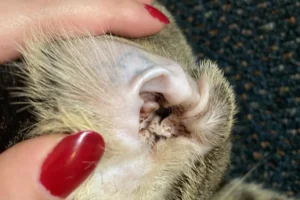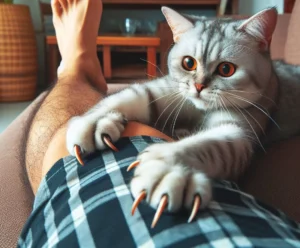Have you ever noticed your cat kicking his back leg when you scratch his ear? It’s a common behavior in felines that can seem puzzling at first. But fear not, there’s a simple explanation behind this quirky habit.
When you scratch your cat’s ear and he starts kicking his back leg, it’s actually a response triggered by an instinctual reflex. This behavior is known as the “scratch reflex” and is a normal reaction in cats when a certain area of their body is stimulated. So why exactly does your cat do this? Let’s delve into the reasons behind this fascinating feline behavior.
Sensory Overload: The Connection Between Ears and Feet
When you scratch your cat’s ear and they start kicking their back leg, it might seem like a random response. However, there’s actually a fascinating connection between their ears and feet. Cats have a unique sensory system that interconnects different parts of their body, including their ears and feet.
The sensitive nerves in a cat’s ear are linked to their spinal cord, which then triggers a reflex that causes their back leg to kick when stimulated. This reflex is a natural response designed to protect them from potential threats or irritants that may be near their ears. So, the next time your cat kicks when you scratch their ear, remember that it’s just their body’s way of reacting to the stimulation.
Grooming Instincts: Mimicking Mother Cats
Have you ever noticed that when kittens are groomed by their mother, she uses her rough tongue to clean their ears? Well, the kick reflex when you scratch your cat’s ear actually ties back to this grooming instinct. When a cat’s ears are scratched, they may interpret it as a grooming behavior and instinctively try to clean themselves.
By kicking their back leg, cats mimic the motion of their mother’s tongue during grooming. This action helps them maintain cleanliness and hygiene, even though they may not actually be cleaning their ears. It’s a fascinating glimpse into the complex grooming behaviors of our feline friends.
Bonus Tip: Provide your cat with regular ear cleanings using vet-approved solutions to help them maintain optimal ear health and reduce the likelihood of excessive scratching and kicking reflexes.
Ticklish or Tolerant: Understanding Individual Differences
Have you ever noticed how some cats simply can’t get enough of ear scratches, while others seem to react as if you’re tickling them? Just like humans, cats have their own unique preferences when it comes to touch. Some felines are more sensitive or ticklish around their ears, causing them to kick their back legs in response to the stimulation. On the other hand, some cats are more tolerant and enjoy the sensation without feeling ticklish. So, if your furry friend starts kicking when you scratch their ear, don’t be alarmed—it’s just their way of reacting to the ticklish sensation in that specific area.
Health Indicators: The Ear as a Gateway to Wellness
Believe it or not, your cat’s reaction to ear scratching can sometimes provide valuable insights into their overall health. Cats have a highly developed sense of hearing, making their ears a vital part of their well-being. If your cat reacts differently than usual when you scratch their ear, it could be a sign of discomfort or an underlying health issue. For instance, an ear infection, ear mites, or even a foreign object lodged in the ear canal could be causing your cat to kick their back leg in response to the discomfort. Paying attention to changes in your cat’s behavior during ear scratching can help you catch potential health issues early on and ensure your feline friend stays happy and healthy.
- Ear Infections: Persistent scratching, head shaking, or a foul odor coming from the ear may indicate an ear infection.
- Ear Mites: If you notice dark discharge resembling coffee grounds in your cat’s ears, it could be a sign of ear mites.
- Foreign Objects: In some cases, cats may kick their back legs when something like a grass seed or small object becomes lodged in their ear canal.
Remember, regular ear inspections and veterinary check-ups are crucial for maintaining your cat’s ear health and overall well-being. If you notice any concerning symptoms or changes in behavior during ear scratching, consulting with your veterinarian is always the best course of action to ensure your cat receives appropriate care.
Environmental Factors: How Surroundings Impact the Kick Reflex
When your cat kicks his back leg while you scratch his ear, it could be due to environmental factors playing a significant role in his response. Cats are highly sensitive to their surroundings, so factors like stress levels or comfort in their environment can influence their behavior.
For instance, if your cat is feeling stressed or anxious, he may react more strongly to certain stimuli, such as ear scratching. On the other hand, if your cat feels safe and relaxed in his environment, he may exhibit a more subdued response. Pay attention to your cat’s body language and overall demeanor to gauge how he is feeling in his surroundings.
Additionally, if your cat is not accustomed to being touched in certain areas, such as his ears, he may exhibit a stronger kick reflex as a protective response. It’s essential to gradually introduce your cat to different types of touch to help him feel more comfortable and reduce any potential triggers for the kick reflex.
By creating a calm and comforting environment for your cat, you can help mitigate any stress or discomfort that may contribute to his kick reflex when you scratch his ear. Providing a safe space and positive experiences can go a long way in helping your cat feel at ease during grooming sessions.
Training Techniques: Utilizing the Kick Reflex for Positive Reinforcement
When your cat kicks his back leg while you scratch his ear, you can actually use this natural reflex for positive reinforcement in training exercises. The kick reflex is a behavior that many cats exhibit when they are enjoying a pleasurable sensation, such as ear scratching.
To leverage this reflex for training purposes, you can associate the ear scratching with a reward, such as a treat or verbal praise. By pairing the scratch with a positive stimulus, you can help reinforce the desired behavior and create a positive association for your cat.
One effective training technique is to scratch your cat’s ear for a few seconds, then immediately reward him with a treat. Repeat this process consistently to help your cat understand that the ear scratching results in a pleasant outcome. Over time, your cat may start to associate the ear scratching with the reward, making him more receptive to the behavior.
By using the kick reflex as a training tool, you can strengthen the bond with your cat and encourage positive behaviors through positive reinforcement. Remember to be patient and consistent in your training efforts to see the best results.
Additional Unique Insight: Did you know that the kick reflex, also known as the “scratching reflex,” is a common behavior seen in many feline species and serves as a way for cats to groom themselves and ward off potential threats in the wild? By understanding the evolutionary purpose of this reflex, you can gain insight into why your cat exhibits this behavior when you scratch his ear.
Fun Facts About Feline Behavior
Have you ever noticed your cat kicking their back leg when you scratch their ear? This quirky behavior actually has a fascinating explanation! When you scratch your cat’s ear and they start kicking their leg, it’s usually a sign of pure bliss. Cats have sensitive nerves in their ears that are connected to the back legs, so when you hit that sweet spot while scratching, it elicits a reflexive kicking reaction. Think of it as your cat’s way of saying, “Yes, right there, that feels amazing!”
Fun Fact: Some cats may even “make biscuits” with their paws while you scratch their ears – a behavior reminiscent of kneading from kittenhood that signifies contentment and relaxation. So, next time your feline friend starts kicking their back leg during ear scratches, just know they’re in kitty heaven!
- Cats have a specialized gland at the base of their tail that releases unique scents when they rub against objects or people. This behavior, known as “bunting,” is a way for cats to mark their territory and show affection simultaneously.
- The famous “cat nap” is not just a cute habit – it’s actually deeply rooted in a cat’s biology. Cats are crepuscular creatures, meaning they are most active at dawn and dusk. So, those frequent naps throughout the day help them conserve energy for their peak hunting times.
Alex, a passionate animal lover, has experience in training and understanding animal behavior. As a proud pet parent to two dogs and three cats, he founded AnimalReport.net to share insights from animal experts and expand his knowledge of the animal kingdom.









